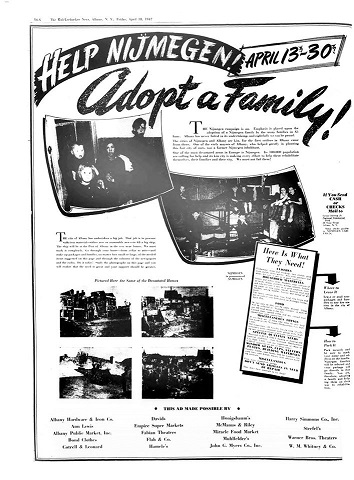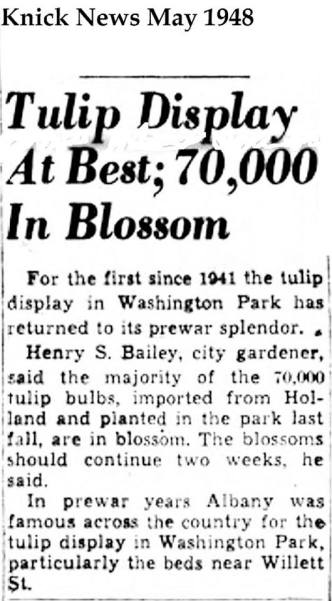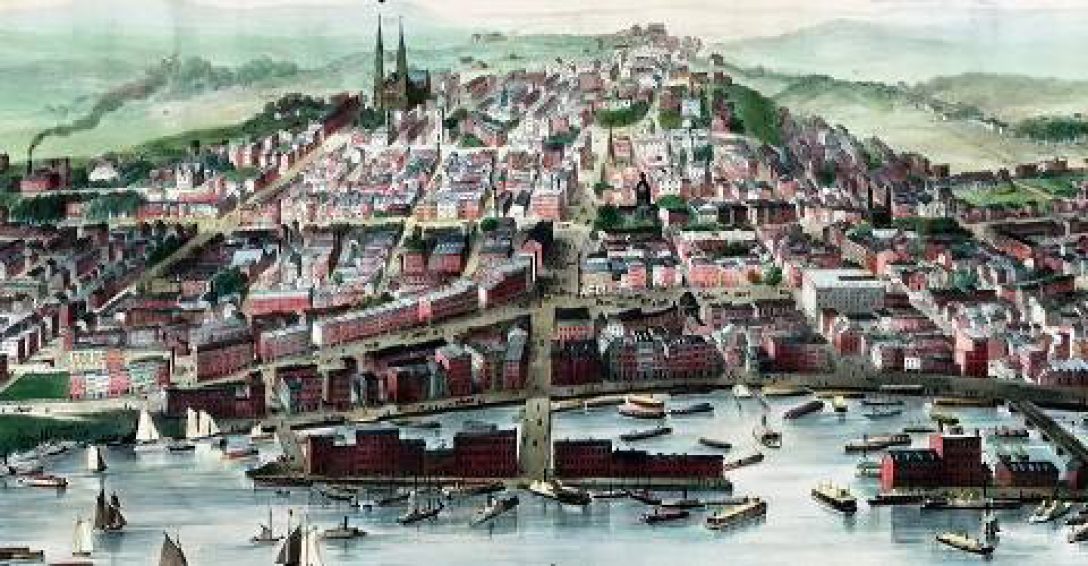It sounds pretty straight forward. In summer 1948 the Albany Common Council enacted an ordinance establishing a tulip celebration in the City and the first Tulip Festival was held in May 1949. But the back story is way more than that and its origin lies in the horrors of World War II.
It started after D-Day in 1944 in Normandy. In September, 1944 the Allies launched Operation Market Garden in the Netherlands to try to capture several bridges in the center of Holland near Nijmegen. General James Gavin (82nd Airborne) was in charge of the parachute jump near Nijmegen. The Operation was not as successful as expected. (Cornelius Ryan’s book, “A Bridge Too Far” describes the mission in detail). Albany men were in the thick of it, but fighting alongside their liberators were the people of Nijmegen. There were many Allied and civilian casualties. Nijmegen (the oldest city in Holland) had already endured years of Allied bombings; the fighting that September finished the job. Military action continued in the area for another 2 months.
On the first anniversary of the battle in September 1945 General Gavin returned to Nijmegen. Conditions were dire.

 It was shortly thereafter, in October 1945, Mayor Erastus Corning received the following cablegram, sent by Sgt. Robert Higgins, (Tremont St.) on behalf of General Gavin.
It was shortly thereafter, in October 1945, Mayor Erastus Corning received the following cablegram, sent by Sgt. Robert Higgins, (Tremont St.) on behalf of General Gavin.
“The 82nd Airborne Division was cited for gallantry by the people of Nijmegen, who expressed desire to be adopted by the people of Albany. Maj. Gen. Gavin, C.O. is in sympathy with this request and has expressed desire to bring this to a satisfactory conclusion. I am a native son of Albany.”
From what we can tell, General Gavin decided the courageous people of Nijmegen needed help and Albany was going to provide it. Why Albany? Was it just random? Nijmegen’s most famous native son was Brant Van Slichtenhorst who had lived in Beverwyck (Albany) in the 1640s when he was director of the holdings of the colony of Rensselaerwyck. (Today Nijmegen’s most famous native son is Eddie Van Halen.) Other explanations have been offered: it was Albany G.I.’s who asked Gavin, it was the legend of Mayor Corning’s brief, but apparently distinguished wartime career. Whatever. Gavin picked Albany and Albany it would be.
There was then a letter from General Gavin to the Mayor, in which he described the bravery of the people of Nijmegen and said there was no people more deserving of assistance from Albany.
We couldn’t say no.
 So Albany adopted Nijmegen and she became our sister city. We sent the people who had nothing what we had, despite the fact we were still under rationing. We sent clothes and food and everyday items we took for granted, like chess sets, books and hammers and shovels. The first donations were collected and shipped in late 1945 and continued throughout 1946, with HUGE campaign in April, 1947.
So Albany adopted Nijmegen and she became our sister city. We sent the people who had nothing what we had, despite the fact we were still under rationing. We sent clothes and food and everyday items we took for granted, like chess sets, books and hammers and shovels. The first donations were collected and shipped in late 1945 and continued throughout 1946, with HUGE campaign in April, 1947.
 Delegations from Nijmegen (and General Gavin) visited Albany and the citizens of Albany visited Nijmegen. Every attempt was made to link the people of Nijmegen and Albany. We re-immersed ourselves in our Dutch culture along the way.
Delegations from Nijmegen (and General Gavin) visited Albany and the citizens of Albany visited Nijmegen. Every attempt was made to link the people of Nijmegen and Albany. We re-immersed ourselves in our Dutch culture along the way.
 And the people of Nijmegen who had nothing, learning of a tulip famine in the US, sent us what they had: 21,000 tulip bulbs. As the Dutch envoy said, “Although you receive only a tulip bulb for your generous gifts, because my people have no more to give, this flower comes right out of their hearts and its beauty expresses their deep gratitude.”
And the people of Nijmegen who had nothing, learning of a tulip famine in the US, sent us what they had: 21,000 tulip bulbs. As the Dutch envoy said, “Although you receive only a tulip bulb for your generous gifts, because my people have no more to give, this flower comes right out of their hearts and its beauty expresses their deep gratitude.”
But the horrendous conditions in Njimegen continued and its people were still going hungry. By early 1947 most food rationing in the U.S. had ended and Albany launched one last major campaign in April. The honorary chair was General Gavin. The people of Albany gave; we literally sent a boatload.

 In the process of helping the people of Nijmegen we re-connected with our Dutch roots and fell under the spell of the tulip. The City established a Tulip Committee. Spring displays citywide rivaled their pre-War glory. In spring 1948 we asked the Queen Wilhelmina of Holland to designate variety of tulip to be Albany’s official flower. She choose the “Orange Wonder”, a Mendel strain of tulip first cultivated in 1934. (It’s now also known as the “The Tulip of Albany”.)
In the process of helping the people of Nijmegen we re-connected with our Dutch roots and fell under the spell of the tulip. The City established a Tulip Committee. Spring displays citywide rivaled their pre-War glory. In spring 1948 we asked the Queen Wilhelmina of Holland to designate variety of tulip to be Albany’s official flower. She choose the “Orange Wonder”, a Mendel strain of tulip first cultivated in 1934. (It’s now also known as the “The Tulip of Albany”.)
 The upshot of this “Tulip Mania” was a suggestion by the City Editor of the Knickerbocker News, Charlie Mooney, that Albany establish a Tulip Festival. We were off and running. The first tulip festival was envisioned as merely displays of tulips. By the time the first Tulip Festival was held in 1949 we established the traditions we know have now, more or less. There was the election of a Tulip Queen (and a Tulip King and Tulip Princess and Prince- the latter members of tulip royalty fell by the wayside in the early 1950s), festivities in Washington Park and a re-connection with our Dutch roots.
The upshot of this “Tulip Mania” was a suggestion by the City Editor of the Knickerbocker News, Charlie Mooney, that Albany establish a Tulip Festival. We were off and running. The first tulip festival was envisioned as merely displays of tulips. By the time the first Tulip Festival was held in 1949 we established the traditions we know have now, more or less. There was the election of a Tulip Queen (and a Tulip King and Tulip Princess and Prince- the latter members of tulip royalty fell by the wayside in the early 1950s), festivities in Washington Park and a re-connection with our Dutch roots.



Copyright 2021 Julie O’Connor

